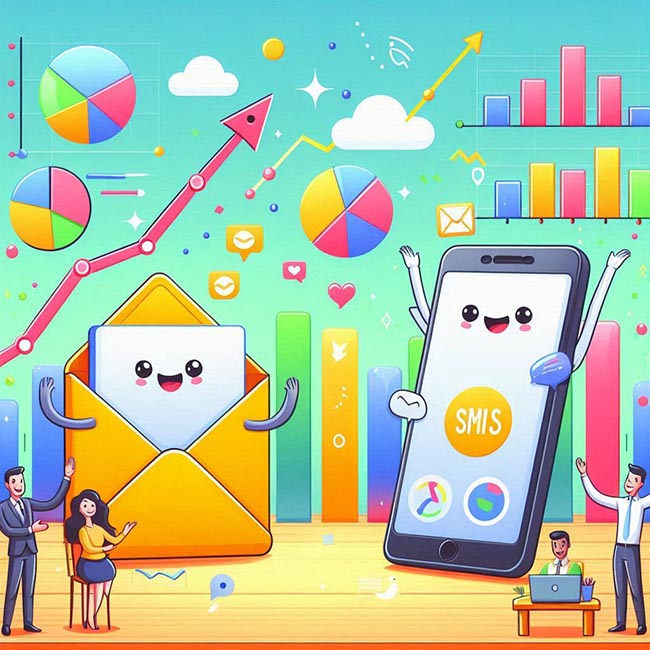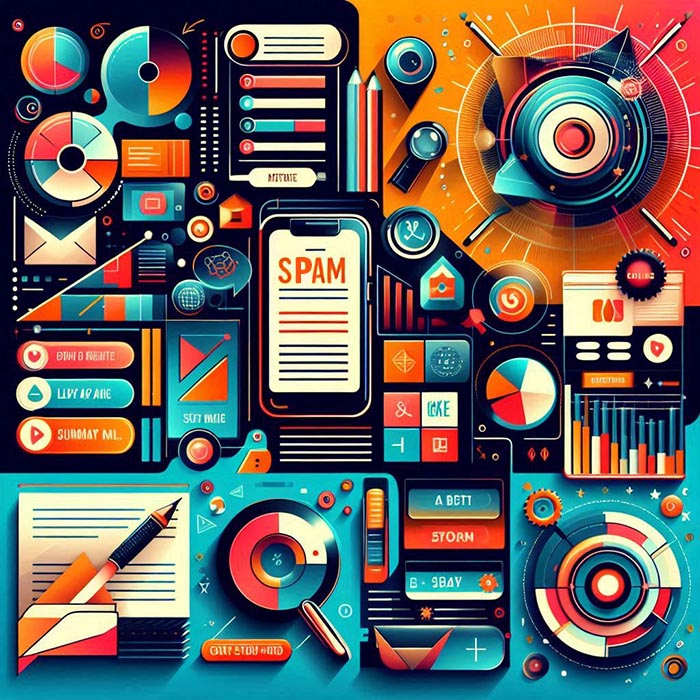Email Marketing vs. SMS Marketing: Which One Works Best?

Today, I’m diving into the battle between email marketing and SMS marketing to see which one truly stands out. Email marketing is all about sending messages through electronic mail to promote products or services.
It shines in driving conversions with an unbeatable return on investment (ROI) among digital strategies. On the flip side, SMS marketing sends text messages directly to phones, boasting a whopping 98% open rate that far surpasses email’s engagement rates.
Both methods come with their own sets of advantages like affordability for emails and instant audience connection for texts.
We’ll compare several aspects such as open rates, click-through rates, costs, customization options, and response times. Understanding these will help us see why knowing your audience and goals shapes your choice between them.
Real-life case studies will offer concrete examples of these tactics in action.
Get ready to learn how to pick the right strategy for you!

Understanding Email Marketing
Email marketing focuses on sending messages to clients and prospects through email. It aims to build relationships, inform customers, and promote products or services effectively.
Definition and purpose
Email marketing refers to using email as a direct marketing tool. It allows businesses to send messages to potential and existing customers. This strategy helps in building relationships and promoting products or services efficiently.
I appreciate how email campaigns can be customized, offering higher engagement through personalized content.
SMS marketing uses text messaging for communication with customers. With an average open rate of 98%, it grabs attention quickly. Its purpose is immediate engagement, making it ideal for urgent promotions or updates.
SMS also offers incredible ROI compared to email marketing, enabling businesses to connect directly with their audience on mobile devices.
Pros and cons
Email marketing and SMS marketing both have unique advantages and drawbacks. Understanding these can help me make informed decisions for a successful marketing strategy.
- Email marketing offers high ROI and excels in driving conversions. I can create targeted campaigns that engage my audience effectively.
- SMS marketing boasts an impressive 98% open rate. This high engagement level grabs attention quickly.
- Customization options are more extensive with email marketing. I can tailor content to fit specific customer preferences.
- Costs for email marketing tend to be lower than those for SMS. This affordability makes it accessible for beginner affiliate marketers like myself.
- SMS engages customers instantly, making it great for urgent promotions. Messages reach recipients quickly and effectively.
- Email has better deliverability rates, ensuring my messages land in inboxes rather than spam folders. A higher click-through rate helps drive traffic and conversions.
- The average read rate for SMS is 42%. This outperforms the 32% read rate of emails, showcasing how well text message marketing communicates with audiences.
- Email allows longer content, which enables deeper storytelling and more detailed information sharing. It enhances the connection with my target audience over time.
- While SMS provides quick engagement, it has limitations on message length. Crafting concise messages becomes crucial in this format.
Choosing between these communication channels requires analyzing my goals and resources clearly. Both methods enhance customer engagement, but selecting one depends on what I want to achieve in my advertising efforts.

Understanding SMS Marketing
SMS marketing grabs attention quickly. With an impressive open rate of 98%, messages reach audiences almost instantly. I find that SMS marketing offers incredible engagement rates, making it highly effective for capturing customer interest.
That high read rate stands at 42%, compared to a mere 32% for email.
This approach allows quick communication and often leads to higher returns on investment than email marketing. Customers respond more readily when they receive text messages rather than emails.
Each message can resonate with the audience right away, sparking immediate action and enhancing customer engagement—something crucial in mobile marketing strategies today. Exploring how SMS compares to email will highlight their unique strengths and weaknesses next.
Comparison of Email Marketing and SMS Marketing
Email marketing and SMS marketing each have their strengths. Email often allows for more detailed content, while SMS captures attention quickly with concise messages.
Metrics to compare (open rate, click-through rate, cost)
Comparing email marketing and SMS marketing is essential for deciding the best strategy. I focus on three main metrics: open rate, click-through rate, and cost. These metrics help us understand which marketing strategy offers more value.
| Metric | Email Marketing | SMS Marketing |
|---|---|---|
| Open Rate | 32% | 98% |
| Click-Through Rate | Higher than SMS, allows for detailed personalization | Engagement rates are high but email excels in driving conversions |
| Cost | More affordable, offering scalability | Higher cost due to direct communication |
I find these comparisons insightful. Next, I’ll explore customization and personalization options.
Customization and personalization
Email marketing offers many ways to customize. It allows me to segment audiences based on preferences and behaviors. I can target specific groups with tailored messages that resonate deeply.
This level of personalization helps improve engagement and conversions. The average click-through rate for email marketing shows this effectiveness.
SMS marketing prioritizes immediacy over extensive customization. Despite its limited options, SMS grabs attention fast. With an average open rate of 98%, my audience sees the messages quickly.
That instant contact enhances response rates significantly, even if personalization is less detailed than in emails. Understanding these differences can help me choose which method suits my goals better in terms of customer communication and engagement strategies.
Response rate
Customization and personalization play an important role in marketing. They directly influence how customers react to messages. The response rate for SMS marketing stands at an impressive 98%.
This high open rate demonstrates its ability to grab attention instantly. In comparison, email marketing boasts a lower open rate of only 32%.
These numbers highlight the effectiveness of SMS marketing in engaging consumers more effectively than emails. With SMS, I see that people often respond quickly. Email still offers great opportunities for detailed communication and campaigns that drive conversions, yet it cannot match the immediate engagement offered by texts.
Each method has its strengths and weaknesses related to customer engagement, allowing me to choose based on specific goals and audience needs.

How to Choose Between Email Marketing and SMS Marketing
To choose between email marketing and SMS marketing, I consider my audience’s preferences and needs. Knowing what they prefer guides my strategy. I also think about my goals for the campaign.
Evaluating my budget helps me decide which method to use. Testing both methods shows me what works best in reaching customers. Real-life examples help to clarify effective tactics too.
If you want to learn more, keep reading!
Knowing your audience
Understanding my audience is crucial in marketing. I first identify who they are and what interests them. For instance, SMS marketing boasts a remarkable 98% open rate, which shows that people engage with messages quickly.
This immediate attention helps me connect better with my audience.
Email marketing offers great customization options. It allows me to craft detailed content tailored to specific needs. The average email read rate stands at 32%. Knowing this helps me decide how much detail to include in my emails compared to SMS messages.
Each method provides its unique benefits based on consumer behavior and engagement levels.
Identifying marketing goals
Setting clear marketing goals helps me focus my efforts. I aim for specific outcomes, whether it’s boosting customer engagement or driving conversions. SMS marketing excites me with its incredible engagement rates and a high ROI.
It boasts an outstanding average open rate of 98%. This means my messages grab attention quickly.
On the other hand, email marketing stands out with the highest ROI in online promotion. It excels at delivering personalized content that resonates with customers more deeply. By understanding these differences between Email Marketing vs.
SMS Marketing, I can tailor my strategy to best fit my audience’s needs and achieve effective communication results.
Considering budget and resources
Budget and resources play a significant role in choosing between email marketing and SMS marketing. I find that SMS marketing can cost more due to the higher fees associated with sending texts.
Despite this, it offers tremendous engagement and boasts an impressive open rate of 98%. Email marketing presents a more affordable option while delivering high ROI. It excels in driving conversions, making it appealing for those on tighter budgets.
Understanding my available resources helps me decide which method suits my needs best. I see that email campaigns allow for creativity with longer content and customization options, giving me flexibility in communication.
On the other hand, SMS grabs attention instantly but lacks depth. Each method holds its own advantages and disadvantages based on what I’m aiming to achieve with my marketing efforts.

Testing and analyzing results
Testing and analyzing results is essential for effective marketing. I need to understand which strategy delivers the best outcomes.
- Measure engagement rates. SMS marketing has an impressive average open rate of 98%. This statistic highlights its potential for immediate engagement compared to email’s 32% open rate.
- Track conversion rates. Email marketing offers the highest ROI and excels in driving conversions. I must evaluate how each method affects my sales and leads.
- Analyze cost-effectiveness. Email marketing tends to be more cost-effective than SMS marketing. Comparing costs helps me allocate resources better.
- Experiment with different content types. Testing images, links, or plain text can reveal what resonates most with my audience across both platforms.
- Gather feedback from subscribers. Engaging directly with users provides insights into their preferences for communication methods.
- Utilize A/B testing strategies. Sending variations of emails or SMS messages allows me to see which performs better in terms of open rates and click-through rates.
- Review metrics regularly. Continuous analysis keeps me informed about trends in either strategy, helping refine my approach over time.
- Adapt based on results collected from both channels. Understanding how each method performs enables me to adjust tactics promptly based on real data.
- Implement changes gradually based on findings to ensure a smoother transition and minimize disruptions in delivery effectiveness across email marketing comparisons or SMS campaigns.
- Document all findings meticulously for future reference, allowing for an informed strategy as I develop skills in online marketing effectiveness through trial and error.

Case studies: real-life examples
I explored the case of a small retail business that switched from email marketing to SMS marketing. They previously sent out regular emails and noticed only a 32% read rate. After transitioning to SMS, their open rate soared to 98%.
This shift led to increased engagement with customers, resulting in significantly higher sales. In just one campaign, they achieved an impressive return on investment of over 200%.
Another example involved a non-profit organization using both methods. Email campaigns offered great customization options but had lower click-through rates compared to their SMS efforts.
The direct nature of text messaging helped them connect instantly with donors during urgent fundraising events. Analyzing these cases shows how each approach can fit specific needs and goals based on the target audience’s behavior and preferences regarding communication effectiveness in “Email Marketing vs.
SMS Marketing: Which One Works Best?”.
Conclusion
Choosing between email marketing and SMS marketing depends on my goals. Each method has its strengths. SMS offers instant engagement with high read rates. Email provides cost-effective solutions with deep customization options.
I recommend analyzing audience needs to find the best fit for my strategy.
Now let’s examine how email marketing vs social marketing compares.